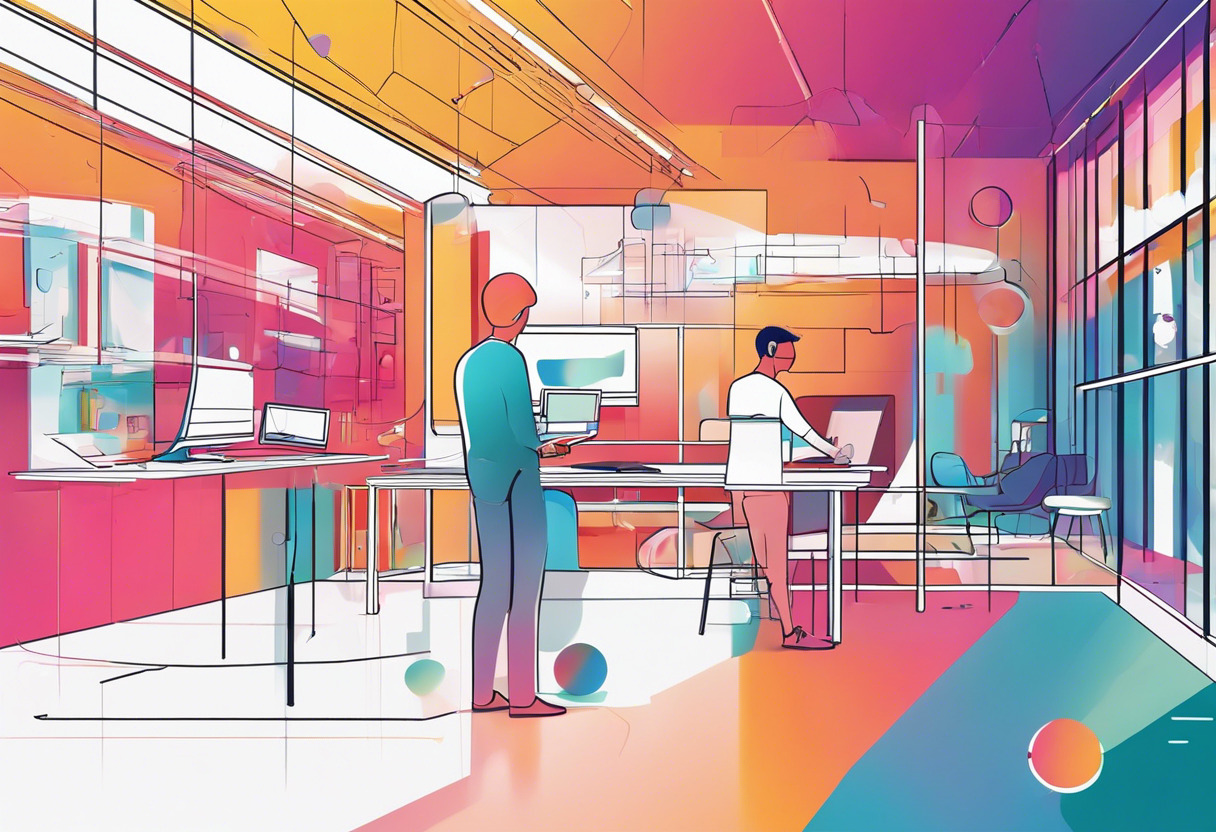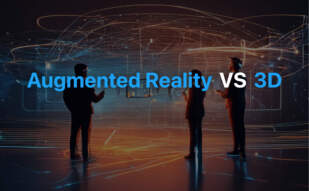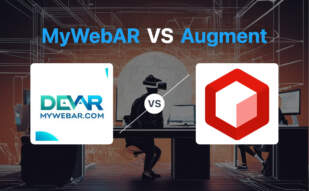Augmented Reality (AR) and Virtual Reality (VR) both offer immersive experiences but in different ways. AR enhances your real world with virtual elements, ideal for remote work, advertising and retail industries, supported by technologies like SLAM. In contrast, VR draws you into a completely virtual world, created for fully immersive gaming, training and simulations using headsets. The choice depends on your intended use.

Key Differences Between Augmented Reality and Virtual Reality
- Stimulation: AR overlays virtual enhancements on real world, VR creates a simulated reality.
- Origin: AR technology conceptualized in 1968; VR’s roots trace back to the 1800s.
- Devices: AR employs mobile devices and glasses, VR relies on head-mounted displays and sensory gloves.
- Real-World Interaction: AR involves interaction with the real environment, VR explores within a simulated space.
- Applications: AR is widely used in retail, advertising and outdoor events, VR more prevalent in gaming and training simulations.
- Technology: AR uses Marker-based and Marker-less techniques, VR simulates sensory experiences and fields of view.
- Development Milestones: Commercial AR application unveiled in 2008; VR gained momentum post Facebook’s Oculus VR acquisition in 2014.
| Comparison | AR Technology | VR Technology |
|---|---|---|
| Development Origin | Ivan Sutherland, 1968 | Morton Heilig’s Sensorama, 1956 |
| First Commercial Use | German agencies in Munich, 2008 | Virtuality arcade machine, 1990 |
| Key Technologies | AI, AR software, processing, lenses, sensors | HMD, multisensory stimulation, computer-generated environments |
| Successful Implementation | Make-up companies’ virtual “try-on” | Oculus Rift prototype with 90-degree field of vision |
| Major Contribution | AR overlay enhances real-world reality | Creating immersive, 3D visuals |
| Application Fields | Marketing, fashion, tourism, retail industries | Military, flight simulation, entertainment |
| System Types | Marker-based and marker-less | Sensorama with multisensory simulation, HMD with stereoscopic 3D visuals |
| Future Potentials | Remote work, enhanced collaboration | Full immersion VR, like ‘windows into a virtual world’ |
What Is AR overlay and Who’s It For?
AR overlay, an advanced technology developed by Harvard computer scientist Ivan Sutherland in 1968, significantly enhances real-world reality without entirely replacing it. AR creates an immersive experience by incorporating digital and physical backgrounds, real-time interactions, and accurate 3D recognition of objects, through devices such as glasses or a camera lens. The success of AR can be attributed to several factors including meaningful content, an interplay between the virtual and physical, and its unique values surpassing other technologies.
Primarily for individuals seeking to enrich their daily experiences, AR’s broad applications range from marketing and retail, to tourism and fashion. It is also continuously expanding in realms such as remote work, and contributing to cultural institutions.

Pros of AR overlay
- Enhances real-world reality, creating a seamless blend of virtual and physical
- Utilized across various industries
- Supports remote work and enhanced collaboration
Cons of AR overlay
- Requires powerful devices for supporting AR software and tracking systems
- The “try-on” feature, though successful, is currently limited to specific industries
What Is Virtual Reality and Who’s It For?
Coined in the mid-1980s by Jaron Lanier, Virtual Reality (VR) is a technology that immerses users in computer-generated simulations of 3D environments. Considered ‘windows into virtual world’, VR experiences, from World War-era sensory stimulation to modern Oculus Rift prototypes, have been revolutionizing not only entertainment, but also fields such as military, tourism, and therapy. These simulations offer a multisensory experience, involving visuals, sounds, and at times, sensations of touch.
VR is intended for anyone interested in immersive simulated experiences. It’s used for education, military training, video gaming, and even therapy.

Pros of Virtual Reality
- Provides immersive, multisensory experiences
- Expansive usage across multiple fields
- Opportunity for remote viewing of potentially hazardous situations
Cons of Virtual Reality
- Requires specialized equipment for an optimal experience
- May cause motion sickness in some users
Augmented Reality vs Virtual Reality: Pricing
While the text provided does not outline specific pricing details for both technologies, it highlights the substantial investment in their development and evolution over time.
Augmented Reality
From its beginnings with Ivan Sutherland in 1968 to its modern deployment in advertising, fashion, tourism, and retail, AR technology investment has increased with its applicability. Potential in remote work, enhanced collaboration, gaming, and interactive experiences like virtual try-ons supports continued growth. Although no specific prices are mentioned, the implication is a significant budget allocation for AR technology development, evidently led by the adoption of technologies like AR glasses and SLAM (Simultaneous Localization And Mapping).
Virtual Reality
Virtual Reality has an equally rich history, tracing back to the 1800s and the era of practical photography, through significant developments including Heilig’s Sensorama in 1956 to Oculus VR acquired by Facebook for $2 billion in 2014; visualization has significantly evolved over two centuries. Given descriptions regarding the development of flight simulators by Furness and subsequent military applications, significant expenditure is suggested in the evolution of VR. Yet, as with AR, no specific price points are given in the provided text.
Code Examples for Augmented Reality & Virtual Reality
Augmented Reality: 3D Text in AR.js
This code allows you to display 3D text augmented on a marker using AR.js. Ensure you’ve imported AR.js and A-FRAME libraries to get this code running smoothly.
<a-scene embedded arjs>
<a-marker preset="hiro">
<a-entity text="value: Hello, AR!; color: red;" position="0 0 0"></a-entity>
</a-marker>
<a-entity camera></a-entity>
</a-scene>Virtual Reality: 360-degree Image Viewer in A-Frame
The following code allows you to create an immersive 360-degree image viewer using the A-Frame library—a popular VR library in JavaScript. Take note to provide an actual image URL in the place of ‘image-url’.
<html>
<script src="https://aframe.io/releases/0.9.0/aframe.min.js"></script>
<body>
<a-scene>
<a-sky src="image-url" radius="10"></a-sky>
<a-camera>
<a-cursor></a-cursor>
</a-camera>
</a-scene>
</body>
</html>In the AR vs VR Battlefield, Which Camp Should You Join?
As we arrive at the crossroads of these two transformative tech revolutions, augmented reality (AR) and virtual reality (VR), one question remains: which should you champion?
Developers & Game Makers
For those immersed in game development, AR presents a divergent canvas. Creating interactive, immersive games that mesh the real world with virtual designs presents a unique challenge. AR’s potential in location-based games, enjoy wider adoption and device proliferation. You’re not tethered to a console; the world is your playground.

Advertisers & Retailers
For the advertisers and retailers out there, AR emerges as a game-changer. Its ability to project digital products for a virtual “try-on” experience, brings enhancement over traditional sales techniques. Users evaluating a product virtually ‘in context’ means improved customer engagement and conversions.

Cultural & Educational Institutions
Cultural and educational institutions would find AR a powerful engagement tool. AR can elevate the exploration of cultural, historical, and geographic aspects of an environment, changing the game for museum visits, city tours or heritage sites. VR’s fully immersive technology reigns for high-impact simulations and learning experiences. However, its adoption is constrained by hardware requirements and cost limitations.

AR and VR hold immense promise, each with its distinct flavor of immersive tech. For interactivity, broader deployment, and immediate impact—AR rules. For full immersion and depth of experience—bet on VR. The choice, as always, remains with user intent and application environment.
Hannah Stewart
Content writer @ Aircada, tech enthusiast, metaverse explorer, and coffee addict. Weaving stories in digital realms.





